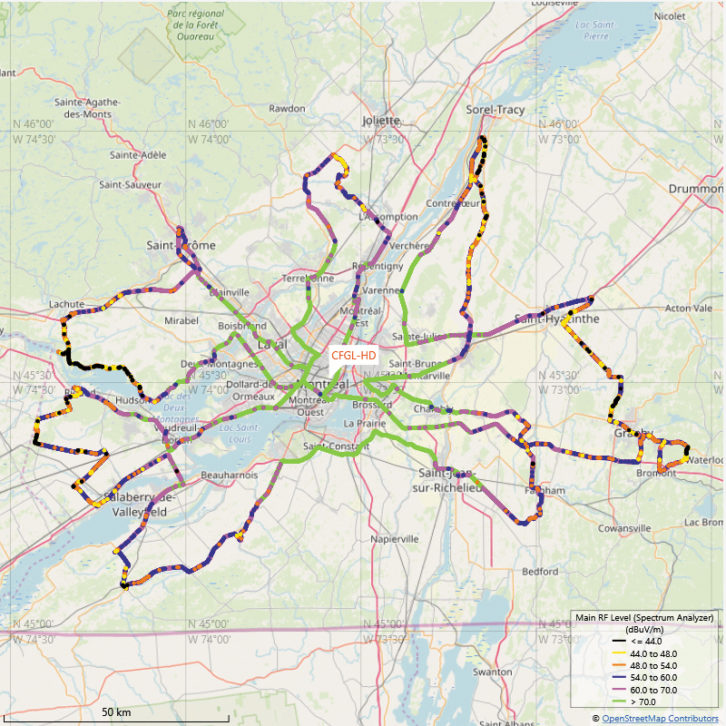
Field-measuring an FM or HD Radio propagation pattern is a time-consuming, mind-numbing task. It’s not quite up there with watching paint dry but it can be close.
The reason: Even with the latest in computerized data collection equipment, conventional measurements require an engineer to drive inside the antenna’s expected coverage area to collect real-time signal strength readings. This is a task that is repetitive, and can take hours to execute.

The collected FM/HDR measurements are then taken back to the station to create an accurate propagation/coverage map. If this map shows certain areas where signal strength is lower than expected — or that the antenna itself is not performing to specifications — then surprise! It’s time to send the engineer back out to take more measurements to verify the anomalies. (Only afterwards, when an accurate coverage map has been compiled, can work be done at the antenna/transmission site to remedy the problem.)
A piece of equipment called the HDR/FM Nomad Analyze promises to substantially reduce the amount of time associated with measuring and tuning HDR/FM antenna performance. It is made by Octave Communications, a Canadian engineering consulting firm that specializes in radio broadcasting, telecommunications and RF analysis measurement software.
Octave says the Nomad speeds up the field measurement process by having engineers create a “pre-simulation” model of the coverage site before conducting field readings using Nomad’s computer-based measurement system.
READY-TO-USE MAPS
“The presimulation incorporates the expected signal strength across the antenna’s coverage area, creating a predictive model ready to be tested before you hit the road,” said Francois Gauthier, Octave’s president.
“Once you are driving through the coverage area, Nomad compares actual signal reception points using its onboard radio receivers, and compares that data against the pre-simulation. If there are problems, the unit tells you, allowing you to take extra measurements right then,” he said.

“In this way, your field time is spent verifying the pre-simulation — including detecting and investigating anomalies — rather than collecting measurements to build a coverage map after the event,” Gauthier said. “The result is a time-saving, properly documented field measurement map ready to use back at the station, rather than raw data that still has to be compiled.”
Gauthier is a former DAB research engineer at the Communications Research Center in Ottawa and former director of broadcast systems and frequency engineering at Radio-Canada, among other professional credits.
NITTY-GRITTY
According to Octave Communications’ website, the Nomad measures the RF level of HD Radio sideband ratios to analog and interferer carriers along with analog FM RF level recording of each station along the entire FM band. The measured signals are marked on the pre-simulation’s map using WAAS/EGNOS satellites to access and record GPS locational data.
HD Radio metrics recorded by the Nomad (during field measurements) include:
● HD signal acquired
● HD digital audio acquired
● Digital quality
● PAD info (HD Artist, HD Title)
● Artist Experience graphics logging
● CD/NO
● Realtime audio recording (right channel analog and left channel digital) and geotagging for later analysis
FM/RBDS metrics recorded by the Nomad include:
● Analog RF level
● Multipath
● RDS loss
● RDS PI
● SNR
● Stereo indicator
● Realtime audio recording and geotagging for later analysis
The system is capable of logging up to five HDR/FM (analog) channels at a time. Nomad’s pre-simulation model can provide in-car engineers with real-time reports of unexpected RF drops, interfering channels and HD Radio sideband power ratio mismatches, among others. The measurement-loaded pre-simulation model can be downloaded in Excel-friendly CSV and/or Google Earth KML format reports.
Nomad’s pre-simulation is created by modelling the measurement area’s “spectrum picture” using propagation files uploaded from the Octave Propagation Model Cloud Service, which is based upon data the FCC, ISED (Canada) and Mexico broadcasting databases.
When problems are detected field measurements, the Nomad emits audible alarms to warn the driver. This allows them to take additional measurements on the spot, eliminating the need to return to the site afterwards.
“The actual Nomad unit is housed in a portable four-rack rigid case,” said Gauthier. “It comes with a built-in USB spectrum analyzer, a distribution amplifier to share signals received on the unit’s external antenna to the radio receivers in the box, and up to five HDR/FM Inovonics receivers. The software is loaded on the user’s laptop, which connects to the Nomad via a USB cable.”
USER RESULTS
When this article was written, Octave Communications had built four Nomads. Those have been getting serious usage and the results have been impressive.
The Canadian Broadcasting Corp. has been using an HDR/FM Nomad Analyzer after doing FM antenna rebuilds, to verify that actual propagation results match what the engineers had in mind.
“We’ve been using the Nomad for six months, and it is saving us a lot of time,” said Charles Rousseau, chief engineer of CBC/Radio-Canada’s Spectrum Group. “You can compare, in real time, what you’re measuring against the realistic simulation of field strength. Then, as an example, there’s an alarm that will ring if you’re 10 dB down your simulation. You can stop and see what may be wrong. Is that drop always happening in a certain azimuth? Was the antenna not properly installed?
“In the old way of doing things, we would only find out about a transmission problem once we were back in the office or at the hotel at night, and we would have to go back,” Rousseau added. “Since Canada is a large country, finding out about issues in the field after the fact cost us a lot of time and effort.”
GeoBroadcast Solutions is another user. The firm helps radio broadcasters maximize signal coverage and robustness through a number of transmission hardware solutions.
“We’ve been using the Nomad both in the lab and in the field,” said Bill Hieatt, the company’s CTO. “In the lab, the Nomad helps us gather measurements associated with the in-vehicle radio transmission test units we operate on behalf of our broadcast clients, where we can literally simulate signal fading and the impact of vehicle speeds without actually driving. In the field, the Nomad is useful in detecting problems like second adjacent channel interference, which is a growing issue as more HD subchannels are being turned on, and transmitter power is being boosted to cut through interference.”
Like the CBC, GeoBroadcast Solutions is happy with the Nomad’s performance, portability and time-saving capabilities. “The fact that the Nomad automatically measures second adjacent channels is a real advantage for us,” Hieatt said. “This unit helps us detect and discover problems that we might otherwise have missed.”







